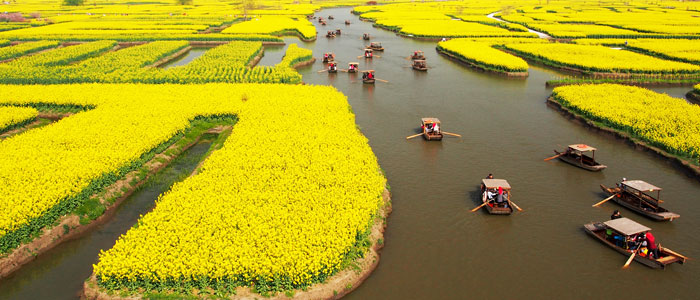Agrosystème Xinghua Duotian, Chine
SIPAM depuis 2014

Informations détaillées |
|---|
Localisation: Xinghua Duotian, Jiangsu, P.R.China
Surface du SIPAM: 312 Km2, parmi lesquels la zone centrale est de 40 Km2
Population travaillant pour ce système: 170409 personnes
Caractéristiques topologiques: couché à faible champ soulevé zone écologique des zones humides
Classification climatique: climat de mousson humide subtropicale
Groupes ethniques / populations autochtones: Principalement Han, mais aussi Zhuang, Miao, Dong, Hui et Li personnes
Principales sources de revenus: agriculture
----------------------------------------------------------------------------------
Global importance
Xinghua Duotian agrosystem is a world-level wonder for its unique water-land utilization method in low-lying land and its splendid raised field landscape. In the past thousands of years, in order to fight against floods, the ancestors in Xinghua built wooden structure to support field, raised mud into small stacks, and formed the original raised field. They developed a unique way of water-land utilization and turned water area and wild land into cultivable land.
Nevertheless, this agrosystem is facing great threat as a result of potential floods caused by lowering raised field, destruction brought by urbanization and construction, larger impact of modern agricultural technology, as well as inadequate personnel and financial support.
Food and livelihood security
Raised field is mainly used to grow vegetable. It was also used to plant crops or trees. Farmers could also farm fish, shrimp or raise ducks and gooses in the water. The raised field could not only provide food for the household, but also serve as a good platform of compound management of agriculture, forestry and aquaculture so as to increase farmers' income.
Longxiang taro, Xinghua chive and Xinghua oilseed rape are the three most famous farm products here, which improved the agriculture effectiveness and increased the income for local farmers. In recent years, the total production value of three industries of Xinghua Duotian agrosystem has obviously increased. It is 2.7269 billion RMB of 2013, almost 100 million more than 2012.
Biodiversity and ecosystem functions
Xinghua Duotian Agrosystem is firstly maintaining a high agrobiodiversity with more than 36 traditional varieties of rice but also wheat, bean, millet, sorghum, corn and many other vegetables and fruit: Chinese yam, taro, lettuce, leek, Chinese chive, spring onion, etc. Moreover, these crops are grown up without chemicals that improve the whole biodiversity of the crops (insects, aquatic life, etc.)
Xinghua Duotian Agrosystem also has rich freshwater fishery resources. There are 56 varieties of fish. Shrimp, crab, clam and wild poultry are also abundant. Being well integrated to the environment, this sustainable system provides habitats for the wild life of the region including birds.
In addition, local farmers always raise canal mud besides raised fields to grow taros, and they can also grow crops on the slopes around the raised fields, thus, they could prevent collapse and erosion of raised fields and protect water and soil.
Knowledge systems and adapted technologies
Raised fields were formed by digging up and stacking the sludge in the marshland to form ridges on which the local farmers can plant crops, vegetables etc. It’s a unique pattern presenting a typical compound agriculture-forestry-aquaculture model. Under the trees, vegetables are planted in the fertile soils. The farmers make full use of the water resources by fish farming in the ditches.
The traditional farming practices include using boats to move around in the fields instead of carts, collecting organic fertilizers by dredging up, scraping sludge and gathering aqua-plants, etc. Moreover, farmers use unique seed-reserving methods and bulb seeds selection and reservation techniques. Farmers keep alive traditional irrigation method-bailing water. Indeed, water scoops are used for bailing water. Moreover, Xinghua Duotian Agrosystem has rich aquaculture resources. Traditional fishing methods are still used in this area, such as catching fish using tuck nets, hurdles, covers and nets.
Cultures, Value systems and social organizations
This agro system has not only provided unique water-land use method and landscape, but also cultivated unique planting culture, architecture, food and drinking culture, as well as folklore culture with raised field characteristics. The topography of Duotian has shaped the lifestyle of the local people, not only are their living habits affected, but also their behavior, knowledge and philosophy.
People in this area highly value traditional festivals, such as the Spring Festival, the Tomb-Sweeping Day, the Dragon Boat Festival and the Mid-Autumn Festival, etc. They celebrate the festivals in different ways, which are maintained in their traditional style until now. In the traversing rivers, we can see barge-women, with colorful kerchiefs on their head, rowing a wooden boat full of joyful tourists and singing folk tunes of water villages in the Lixiahe area.
Remarkable Landscapes, Land and Water resources management features
Xinghua Duotian Agrosystem is covered up by land in 30% and by water in 70%. Due to its unique water and soil utilization method, the landscape has been shaped in a special way: rivers flow gently under small bridges; green-roof buildings stand on both sides of the waterways. The changing and colorful natural landscape was created by the skilled and reasonable land management.
The Xinghua raised field landscape having gone through processes of utilizing nature, building wooden structures to support field and field rising. It is of great scientific value for researchers to study the farming history of this water course network area in China. Water and land resources management are effectively preserved by the farmers as they are the creators of these cultivable lands.

